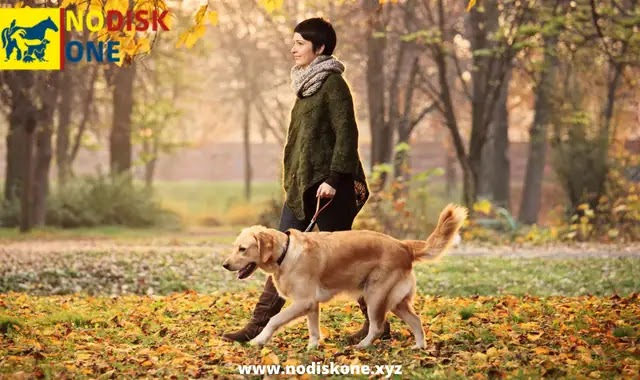Nearly all dogs gain numerous advantages to their physical, mental, and emotional health from daily walks with their owners. Exercise is beneficial for your dog's body, which is what walks offered. Your dog will benefit mentally from walks as well because they allow them to sniff intriguing scents, interact with other dogs and people, and simply explore the outside world.
Long days spent indoors can be broken up with walks, which will lessen boredom and make your dog happier and more at ease all around. Walking your dog is beneficial to you. People and canines both benefit from outdoor strolls in terms of exercise and mental stimulation.
 |
| How Long Should I Walk My Dog? |
It's best to avoid taking some dogs for walks. Dogs with physical issues that prevent them from enjoying a walk safely and comfortably, as well as those with health issues, shouldn't go on long walks (or possibly any walks at all). Some dogs just don't like taking long walks for various reasons, including fear or anxiety.
Consult your veterinarian if you're unsure whether walking is beneficial for your particular dog. So let's explore a few of the frequently asked questions about walking dogs, such as how long should you walk a dog, when is the best time of day to walk a dog, and more.
This is an informative article. Nodisk One is not permitted to make a diagnosis or recommend any form of veterinary care. If your pet is in pain or ill, we recommend that you take him to the vet.
How Long Should You Walk Your Dog?
 |
| How Long Should You Walk Your Dog? |
Your dog's age, breed, and other factors will all affect the answer to this question. Compared to adult dogs, puppies require fewer walks. Puppies easily get tired because they have a lot of energy but not a lot of stamina. The best way to train a puppy to use the potty and walk on a leash is to take them on frequent, brief walks. Aim for quick strolls of five to ten minutes, and take your puppy for a stroll three or more times each day.
Puppies and Senior Dogs
While Senior dogs are typically able to walk for longer distances than young puppies, many seniors dogs require shorter walks than they did as young adults to protect their joints and muscles. In comparison to a young adult dog, your senior dog may also have less endurance and tire out more quickly depending on its age. Aim for one or two daily walks for seniors that last 20 to 30 minutes. If your senior dog is in good health, eager to continue walking, and doesn't limp or become overly stiff after long walks, you can go a little further.
 |
| Puppies and Senior Dogs |
Compared to puppies and senior dogs, adult dogs can take longer walks. Depending on the breed, physical characteristics, and temperament of your dog, your walks may be longer or shorter. The majority of adult dogs are satisfied to go for as many walks as you'll take them. Set a goal of taking them at least two daily walks, and if you have the time, don't be afraid to add one extra walk or two or more.
Small To Large Breeds
Chihuahuas, Maltese, Papillons, Pomeranians, and Yorkshire Terriers are small breeds that typically require shorter walks. To walk the same distance as a bigger dog with longer legs do, those small legs need to move a lot more. Shorter walks may also be necessary for brachycephalic breeds, which include dogs with pushed-in faces like the boxer, bulldog, French bulldog, and pug. This is because the dog may have trouble breathing due to those adorable short snouts, especially when they are exercising.
Long-backed and short-legged dog breeds like the Basset Hound, Dachshund, Pembroke Welsh Corgi, and Scottish Terrier—though this will depend on the breed and individual dog—might need shorter walks. Longer walks are perfectly fine for some short-legged dogs, so consult your veterinarian and determine your dog's capabilities accordingly.
 |
| Small To Large Breeds |
Small dogs, dog breeds with flat faces, and dwarf dog breeds should begin with twice-daily walks that last 15 to 30 minutes. To make these walks easier for your dog, start them when it is cooler outside. If your dog enjoys walking and appears happy to go for longer walks, you can gradually lengthen the walks while making sure to always stop before your dog gets too tired.
If the dog is physically healthy and in good condition, medium to large breeds like the beagle, English springer spaniel, golden retriever, and Labrador retriever can typically go for longer walks. Most of the time, these breeds can easily handle moderately long walks.
Athletic Breeds
Athletic breeds with high levels of stamina and speed include the Australian shepherd, border collie, Siberian husky, vizsla, and Weimaraner. Such breeds can not only benefit from longer walks, but they may even demand them (along with other forms of exercise) to keep calm and happy at home.
 |
| Athletic Breeds |
Start out with twice-daily walks that last between 30 and 60 minutes for medium and large-breed dogs, particularly for athletic breeds. As much as your dog appears at ease with and enthusiastic about, lengthen walks and frequency.
Dog Walking Tips
1) You should always customize your dog's walks. Consult your veterinarian before beginning a new walking routine if your dog is obese or suffers from a medical condition. In general, it's best to gradually increase the distance of your dog's walks. Start with shorter walks and lengthen them by a few minutes every few days if your dog responds well to the activity.
2) Never let your dog become overly tired on a walk. The following are indications that your dog is too tired:
- Slowing down.
- Heavy panting with the tongue sticking out.
- Turning around.
- Lying down.
In this case, let your dog rest for a while before returning home and taking him for a quick walk the next time.
3) Don't take your dog for a walk when it's hot. When it's hot outside, limit your walking to dawn and dusk and, if necessary, reduce the length of your walks. Exercise in extreme heat can result in overheating or even heatstroke, which is an emergency, and walking on hot pavement can burn sensitive paw pads. Heatstroke symptoms include:
- Excessive drooling.
- Panting.
- Gums or tongues that are bright red, blue, or purple.
- Trembling.
- Vomiting.
- Diarrhea.
- Collapse.
If you presume your dog is experiencing heatstroke, take it out of the heat as soon as you can, put cool (not ice-cold) water on its body, and contact a vet right away.
4) If you plan to walk your dog for a long period (more than 30 minutes), it is a good idea to always bring water. Your dog may overheat and become dehydrated even in cooler weather, specifically if it has a long, thick coat or has never walked longer distances.
Dog Walking FAQ
When Is the Best Time of Day to Walk the Dog?
Even though most dogs enjoy going for walks at any time of day, the morning and early evening are typically the best times. These times enable you to walk your dog and take care of any business before you leave for work and after you get home. When walking becomes hazardous due to the midday heat in the summer, these are also the best times of the day. During the early mornings and later evenings when it isn't quite so hot outside, take advantage of the cooler temperatures.
Is skipping a walk with your dog okay?
The majority of dogs really like walking, having said that, going for a walk each day is not required. Many dog owners believe that skipping their dog's daily walks is a sign of failure. In reality, your dog usually has nothing to worry about, and occasionally, they need it the most.
Is a dog able to handle a two-hour walk?
If they are in generally good physical condition, the majority of dogs can tolerate daily 20–30 minute dog walks. Some dogs in excellent physical condition can go on hikes or walks that last up to two hours.
Is taking the same path better for dog walks?
A dog trainer Visconti told nodiskone.xyz: "Allow your dog to choose the route once in a while. The dog gets to experience new sights and scents by switching up the walk route. Although dogs enjoy routines, avoid becoming too rigid with them to get the most out of your walks."
On Which side should a dog walk on?
While most dogs don't care which side they are on, show and hunting dogs are trained to remain by their owners' left side. To avoid the dog accidentally tripping you as you switch sides, experts advise choosing one side (either left or right) and sticking to it.
Only credible sources, such as peer-reviewed studies, are used by Nodisk One to substantiate the information in our articles.

Comments